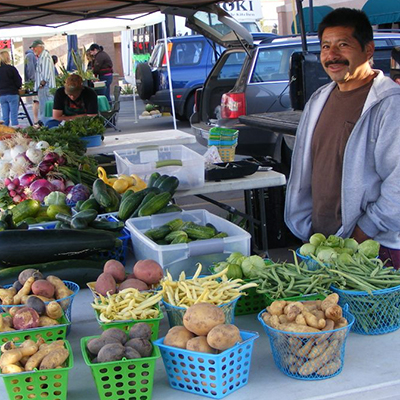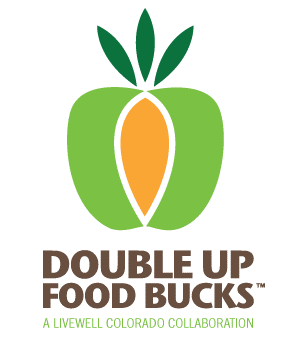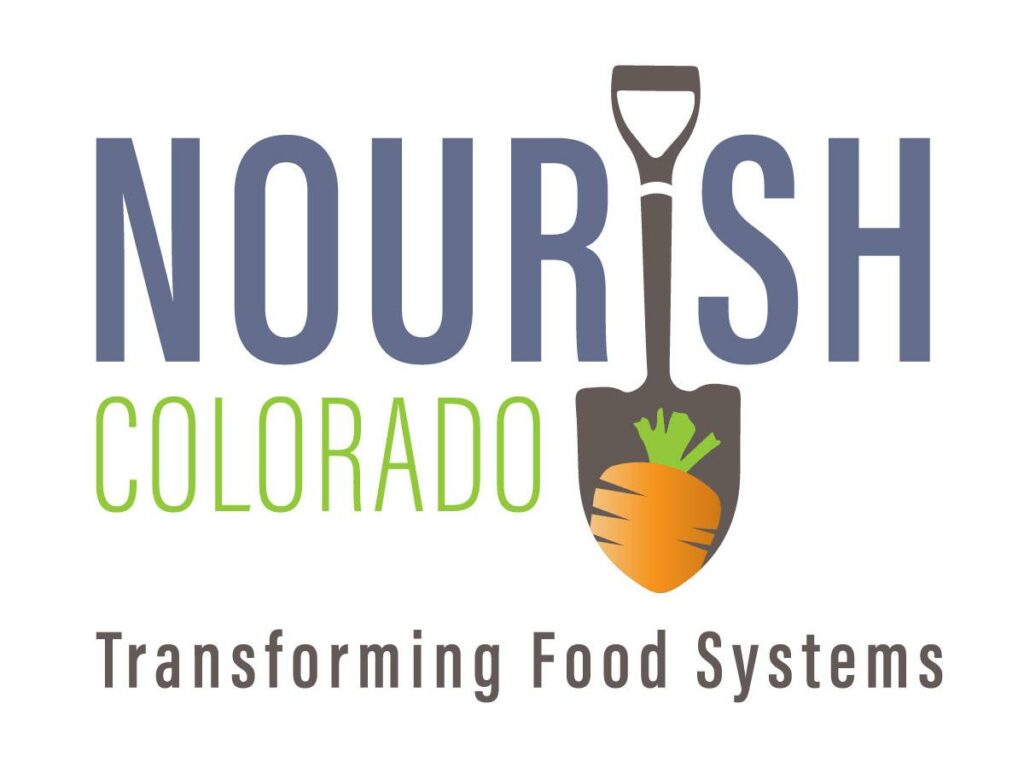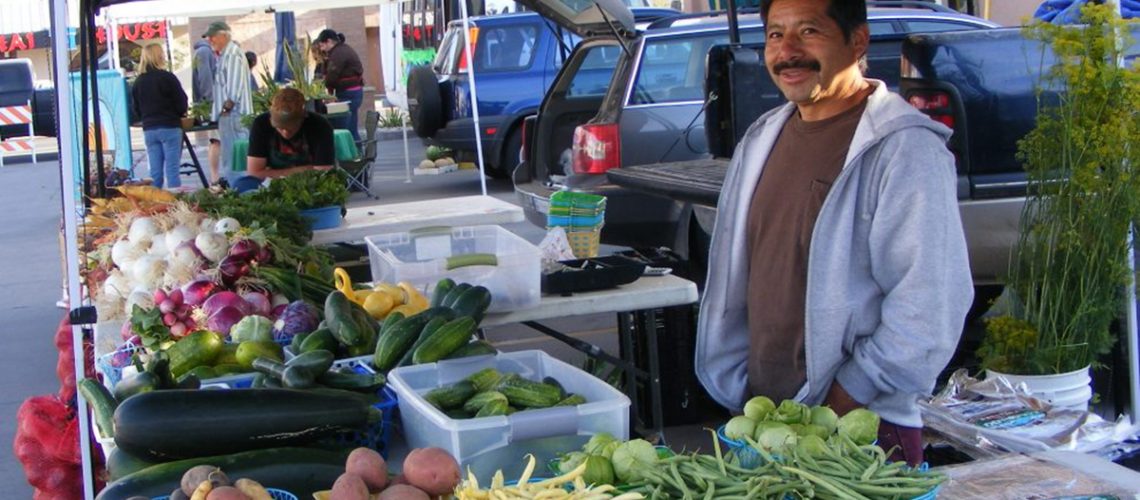USDA Awards Major Grant Benefiting Low-Income Families, Farmers
Double Up Food Bucks Colorado is a win for Colorado’s low-income families, agricultural community and economy

A statewide partnership led by LiveWell Colorado, Colorado Department of Human Services, the Colorado Farmers Market Association, Cooking Matters-Colorado, and Boulder County Public Health has just been awarded a U.S. Department of Agriculture (USDA) Food Insecurity Nutrition Incentive (FINI) grant that will bring more fresh produce to low-income families in 19 counties while supporting Colorado farmers, through the Double Up Food Bucks Colorado program.
“This grant will boost efforts to ensure Colorado families have access to locally grown foods,” Senator Michael Bennet said. “LiveWell Colorado will help put fresh, nutritious food in the hands of those who need it while also supporting Colorado’s farmers and the local economy.”
The USDA grant will help to fund a program called Double Up Food Bucks Colorado, which increases the amount of fruits and vegetables available to low-income Coloradans. With Double Up Food Bucks Colorado, Supplemental Nutrition Assistance Program (SNAP, formerly known as food stamps) recipients will receive up to $20 in Colorado-grown fruits and vegetables when they use their SNAP benefits at participating farmers markets or select retailers. SNAP benefits will be matched dollar for dollar to be put toward Colorado grown, fresh fruits and vegetables, up to $20 per visit. So if a family spends $20 in SNAP benefits at a farmers market, they get an additional $20 to buy more Colorado-grown fruits and vegetables.
“At least 50 partners have come together to make Double Up Food Bucks Colorado a reality,” said Wendy Peters Moschetti, LiveWell Colorado Director of Food Systems. “Increasing access to healthy food for families who are low-income is an integral part of LiveWell Colorado’s strategic approach to combatting obesity. We believe providing SNAP recipients with the ability to purchase more fruits and vegetables is an important step toward that objective.”
 Double Up Food Bucks Colorado will kick off in early July at 30 farmers markets and at five select retailers in 19 counties across Colorado. Over the next three years, the program will expand to more areas of the state to include at least 35 farmers markets and a dozen additional retailers, including Community Supported Agriculture, food co-operatives, corner stores and urban agriculture marketplaces located in low-income neighborhoods. A map of participating sites can be found at www.DoubleUpColorado.org.
Double Up Food Bucks Colorado will kick off in early July at 30 farmers markets and at five select retailers in 19 counties across Colorado. Over the next three years, the program will expand to more areas of the state to include at least 35 farmers markets and a dozen additional retailers, including Community Supported Agriculture, food co-operatives, corner stores and urban agriculture marketplaces located in low-income neighborhoods. A map of participating sites can be found at www.DoubleUpColorado.org.
According to one Coloradan who has benefited from a similar program at the Boulder County Farmers’ Market, “Each time I come and get my dollars matched, I am full of gratitude, relief and I often cry because I am so touched. I can now shop at the farmers market because of food assistance!”
Funding comes from the USDA’s National Institute of Food & Agriculture Food Insecurity Nutrition Incentive Grants (FINI) program, which received bipartisan support in the 2014 Farm Bill. The USDA FINI Grant brings half a million dollars of federal funding into Colorado, including more than $100,000 in cash incentives alone in 2016, with an increase in incentives in years two and three of the program. The grant was matched by more than $899,000 from 26 partners committing financial and in-kind support to make this program possible in Colorado.
Currently, SNAP serves approximately 485,000 Colorado residents each month[i], providing a critical buffer to food insecurity, helping decrease the burdens of poverty, supporting positive long-term health outcomes and benefitting children[ii]. Coloradans who receive food stamps are provided $1.41 per meal or $4.23 per day on average[iii], making it challenging to have enough money to buy food for the whole month.
“Double Up Food Bucks Colorado fills low-income families’ hunger gap by increasing their food-buying power, and designates additional dollars for healthy fruits and vegetables grown by Colorado farmers. In this way, it addresses hunger, improves nutrition, and supports local growers and our local economy,” added Moschetti.
While Colorado adults have the nation’s lowest obesity rate at 21.3 percent,[iv] adults with annual incomes below $10,000 have an obesity rate of 29.2 percent.[v] In 2013, 86 percent of adult Coloradans did not meet recommendations for fruit and vegetable consumption.[vi]
A list of partners participating in Double Up Food Bucks Colorado can be found here.
MEDIA CONTACT:
Sarah Kurz
LiveWell Colorado Vice President of Policy & Communications
1490 Lafayette St., Suite 404
Denver, Colorado 80218
cell: 303-818-3347
sarahkurz@livewellcolorado.org
LiveWell Colorado is a statewide nonprofit organization committed to preventing and reducing obesity in Colorado by promoting healthy eating and active living. With the goal of eliminating health disparities and advancing health equity, LiveWell Colorado focuses its efforts on policy, environmental and lifestyle changes that remove barriers and increase access to healthy behaviors. Working in partnership with obesity prevention initiatives across the state, LiveWell Colorado aims to provide every Coloradan with access to healthy foods and opportunities for physical activity to make Colorado the healthiest state in the nation.
is a statewide nonprofit organization committed to preventing and reducing obesity in Colorado by promoting healthy eating and active living. With the goal of eliminating health disparities and advancing health equity, LiveWell Colorado focuses its efforts on policy, environmental and lifestyle changes that remove barriers and increase access to healthy behaviors. Working in partnership with obesity prevention initiatives across the state, LiveWell Colorado aims to provide every Coloradan with access to healthy foods and opportunities for physical activity to make Colorado the healthiest state in the nation.
Double Up Food Bucks was created by Fair Food Network in 2009. It began at five farmers markets in Detroit, spread statewide to more than 150 sites across Michigan including grocery stores in one of the first pilots in the country, and has since become a model for healthy food incentives implemented by communities nationwide. Today, Double Up programs are active in 13 states with six more states launching efforts in 2016.
[i] Food Action and Resource Center report: Profile of Hunger, Poverty, and Federal Nutrition Programs – updated January 2016. Accessed at: http://frac.org/wp-content/uploads/2011/01/snapdata2016_jan.pdf
[ii] White House Council of Economic Advisors Long-term Benefits of the Supplemental Nutrition Assistance Program. December 2015
[iii] USDA Food and Nutrition Service SNAP Program Data
[iv] Centers for Disease Control and Prevention, National Center for Chronic Disease Prevention and Health Promotion, Division of Population Health. BRFSS Prevalence & Trends Data [online]. 2015. Accessed April 2016 at http://wwwdev.cdc.gov/brfss/brfssprevalence/
[v] Colorado Health Institute analysis of Behavioral Risk Factor Surveillance System, Centers for Disease Control and Prevention (2004-2013)
[vi] Colorado Department of Public Health and Environment (2014). Facts for Action: Chronic Diseases and Related Risk Factors in Colorado, Fruit and Vegetable Consumption in Colorado. Accessed at: https://www.colorado.gov/pacific/sites/default/files/DC_fact-sheet_Fruit-vegetables_Nov-2014_without-Appendix.pdf

